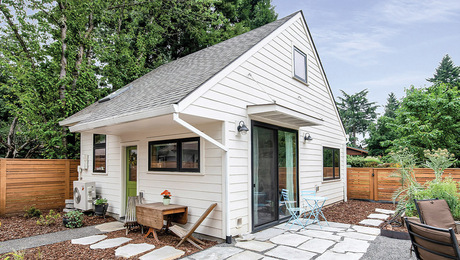Should you be concerned about mold?
Over the past few years, mold has raised increasing concerns among building owners and
construction contractors for the damage it causes to building structures, furnishings, and materials.
This issue of the Construction Depot highlights the health issues related to mold, how to control it,
and what to consider when you need to remove it.
What is mold?
Molds – there are thousands of species – are forms of fungi that exist everywhere in the environment. Most fungi,
including molds, produce microscopic cells called spores that spread easily through the air. Live spores form new
mold colonies when they find favorable growing conditions — primarily oxygen, organic matter, moisture, and
temperatures between 40 F and 100 F.
Are molds harmful?
Though some molds produce substances called mycotoxins that are toxic in high concentrations, there’s no
strong scientific evidence that airborne mycotoxins adversely affect human health in home, school, or office
environments. Most people have no reaction when exposed to low concentrations of mold for a short time.
For those who are sensitive to molds, allergic reactions are the most common health concern. Molds can also
cause flu-like symptoms or a skin rash and can aggravate asthma; however, these symptoms may also be due
to bacterial and viral infections or other allergies. Most health effects caused by mold end when the source is
eliminated.
How to prevent mold
The key to preventing mold is to control excess moisture.
• Keep heating, ventilation, and air-conditioning drip pans clean and unobstructed.
• Keep indoor relative humidity below 60 percent.
• Inspect HVAC systems regularly.
• Ventilate or use exhaust fans (to the outdoors) to remove excess moisture.
• Repair water leaks promptly; dry and clean or replace water-damaged materials.
Materials that stay wet for longer than 48 hours are likely to produce mold
growth.
• Keep foundations dry.
How do molds enter a building?
Mold becomes a problem in homes and commercial buildings only where it finds high relative
humidity and moisture-holding surfaces. Most molds that thrive indoors have outdoor sources.
Following are common ways that molds enter buildings.
How molds enter a building
Source/route Examples
Outdoor air intakes Sources such as standing water, dirt, plant debris, feathers, and bird
droppings that are near outdoor air intakes.
Air filters Microbial growth on filters; gaps between filters and housings;
low-efficiency filters.
Heat exchangers Dirty heating or cooling coils; excessive water in condensate pans;
poorly maintained air washers or humidifiers; stagnant water in
air washers or humidifiers.
Supply-air plenums and ductwork Excessive surface deposits; dampness and surface microbial growth;
inaccessible humidifiers.
Supply air diffusers Surface deposits, rust, or microbial growth on louvers; soiled adjacent
ceilings and walls; poor air mixing.
Water damage Plumbing or roof leaks; water intrusion; indoor humidity
greater than 60 percent.
Chronic condensation Inadequate insulation; humid outdoor air that that causes condensation
on windows, perimeter walls, or other cool surfaces.
Window air conditioners Dirty grills; standing water in condensate pans or sumps;
and evaporative air coolers dampness and surface microbial growth near units.
Fan coil and induction units Dirty heating or cooling coils or filters; excessive water in
condensate pans; dampness and surface microbial growth near units.
Carpet Dirty, poorly maintained, or water-damaged carpet.
Fabric office partitions, Dirty, poorly maintained, or water-damaged fabric-covered
wall coverings, drapes; and upholstered items.
upholstered furniture
Portable humidifiers Poorly maintained units with microbial growth in the water
reservoirs, spray or mist units.
Return air plenums Excessive surface deposits; dampness; surface microbial growth.
Should you test for mold?
Generally, it’s not practical to test for mold. Testing surfaces or monitoring the air tells you little about where
mold is and how to clean it. Also, there are no standards for acceptable levels of mold in buildings; most tests
compare levels and types of mold spores found inside a building with those existing outside. It’s more effective to
identify the mold source and get rid of the mold.
The first thing to do when you discover mold
Identify the mold source and determine how to correct the condition that caused it. The source must be stopped or
repaired to prevent mold from recurring.
What’s involved in cleaning up mold?
The answer depends on the type of contaminated material and the extent of contamination. Use detergent and
water to clean mold from non-porous (hard) surfaces then dry completely. Replace contaminated porous material
such as ceiling tiles, wallboard, and carpeting.
Use a wet vacuum to remove water from rugs and other surfaces where water accumulates. Use it only to vacuum
materials that are still wet, then clean hoses and attachments thoroughly. Steam cleaning may be an alternative for
carpets and some upholstered furniture.
Use high-efficiency particulate air (HEPA) vacuums for final cleaning of contaminated areas after surfaces are
clean and dry. Dispose the contents in sealed plastic bags.
Cleanup work that disturbs mold increases the risk of exposing others. Examples include breaking up moldy
wallboard, removing mold in a wall cavity, stripping or peeling moldy wallpaper, and using fans to dry moldy
material. Before beginning such work, contain the mold so that it doesn’t spread and use appropriate personal
protective equipment to avoid inhaling spores or touching contaminated material.
Containment methods. To keep mold from spreading, enclose the contaminated area – ceiling-to-floor – in
polyethylene sheeting; include a slit entry and a covering flap. Keep the enclosed area under negative pressure
with a HEPA-filtered fan unit. Block supply- and return-air vents in the enclosed area.
Discard contaminated building materials and furnishings that are not salvageable. Double bag the material with
six-millimeter polyethylene sheeting and discard it with other construction waste.
Skin and eye protection. Use rubber gloves to protect skin from mold and from mild cleaning solutions. Use
natural rubber, neoprene, nitrile, or polyurethane gloves with strong cleaning solutions. Use goggles to keep out
dust and small particles; don’t use safety glasses or goggles with open vent holes. Use mold-impervious disposable
protective clothing when doing extensive cleanup work.
Respiratory protection. For cleaning relatively small contaminated areas (10 square feet or less), use a NIOSH
approved N-95 filtering facepiece for protection from mold spores and dust. More extensive cleanup work may
require additional protection such as a half- or full-face respirator with a HEPA filter.
If the source of contamination may contain sewage, hazardous chemicals, or other biological pollutants, you’ll
need to take additional protective measures. Get assistance from an experienced abatement specialist.
Discussion Forum
Discussion Forum
Up Next
Video Shorts
Featured Story

Key proposals for the next edition of the International Residential Code tackle room sizes, stair specs, emergency egress, and deck guards, among other requirements.
Featured Video
Video: Build a Fireplace, Brick by BrickHighlights
"I have learned so much thanks to the searchable articles on the FHB website. I can confidently say that I expect to be a life-long subscriber." - M.K.
Fine Homebuilding Magazine
- Home Group
- Antique Trader
- Arts & Crafts Homes
- Bank Note Reporter
- Cabin Life
- Cuisine at Home
- Fine Gardening
- Fine Woodworking
- Green Building Advisor
- Garden Gate
- Horticulture
- Keep Craft Alive
- Log Home Living
- Military Trader/Vehicles
- Numismatic News
- Numismaster
- Old Cars Weekly
- Old House Journal
- Period Homes
- Popular Woodworking
- Script
- ShopNotes
- Sports Collectors Digest
- Threads
- Timber Home Living
- Traditional Building
- Woodsmith
- World Coin News
- Writer's Digest


















